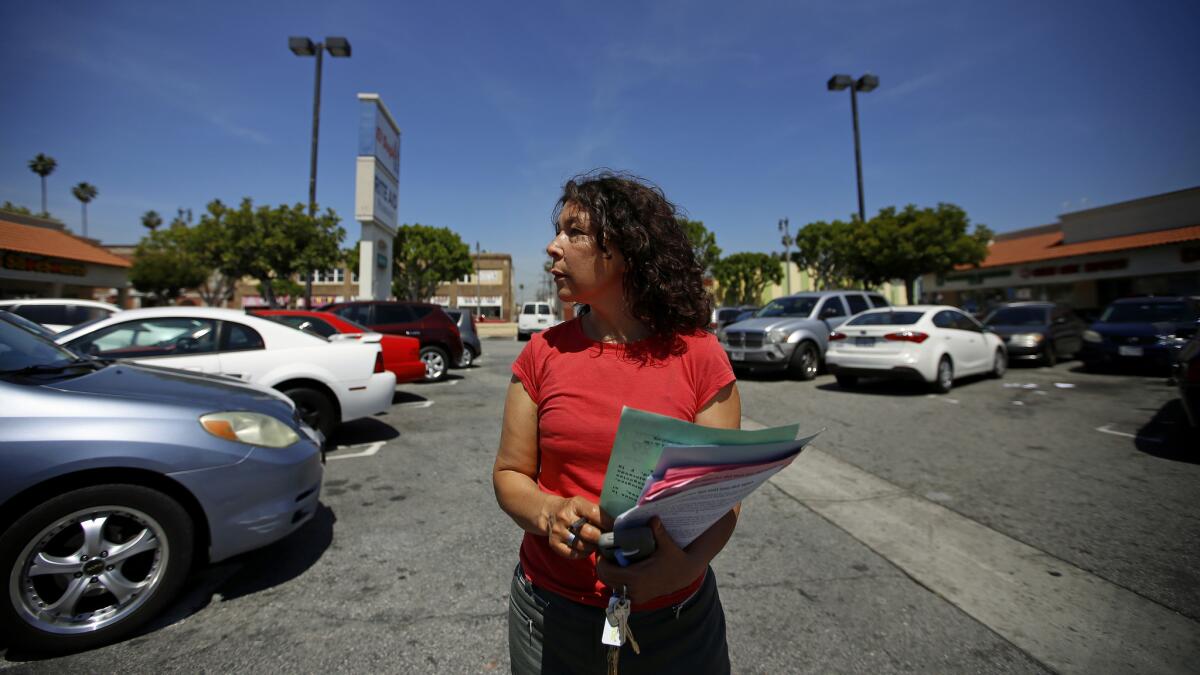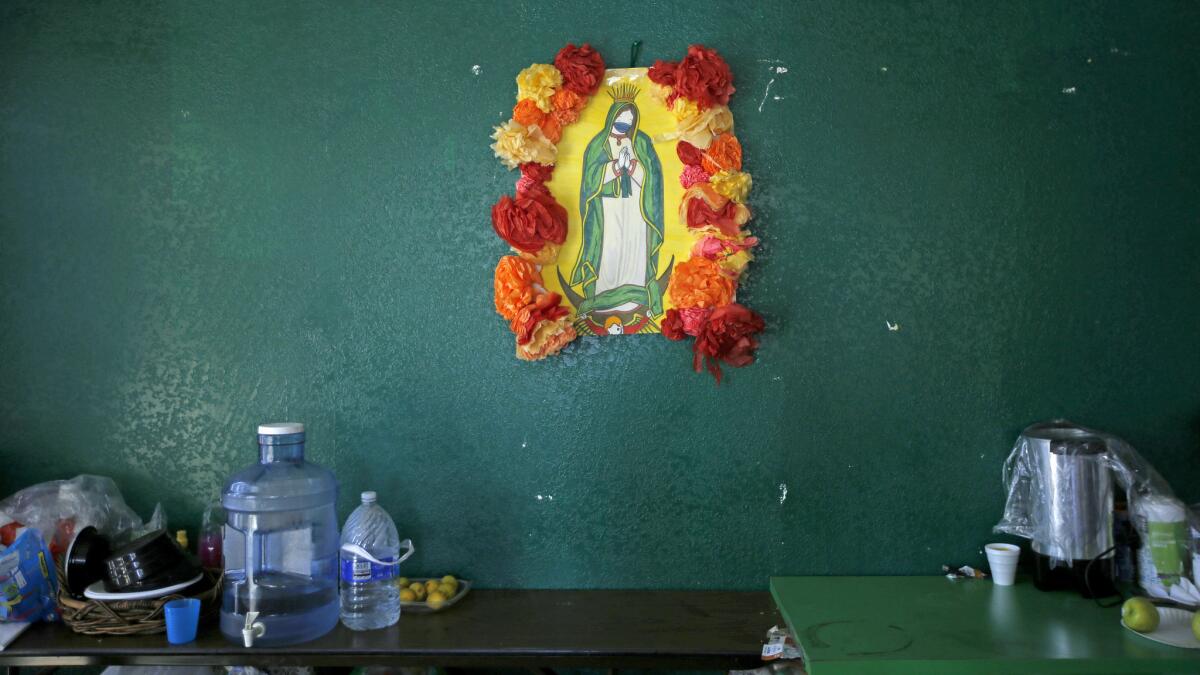Column: California’s environmental crusaders helped save our state. Now, they face down Trump

It did not begin well for Alicia Rivera, who carried a stack of fliers as she made her way around the parking lot of a Wilmington shopping center.
The first person she approached brushed past her, uninterested in her spiel about polluted air in the harbor area’s smokestack neighborhoods.
The next guy shook his head; he didn’t want the flier calling residents to an April 29 climate change march protesting the planned expansion of the nearby Tesoro refinery.
If that wasn’t discouraging enough, these are dark times for someone in the environmental protection movement. President Trump has surrounded himself with climate change doubters and fossil fuel champions, and he has already begun dismantling the Environmental Protection Agency.
But this is California, which has always traveled a higher road, and will continue to do so regardless of what happens in Washington.
Sure, Rivera said, she gets depressed about the pollution pouring out of Washington these days, and worries about Trump trying to scale back higher vehicle emission standards. But as an organizer with Communities for a Better Environment, she’s always acted with a sense of urgency, and maybe she’ll just have to step it up even more.
She scanned the parking lot for another target.
“Not everyone responds the same way,” she told me. “You have to keep trying.”
She did, and it paid off as she connected with a man who wanted to hear all about the April 29 march.
Not everyone responds the same way. You have to keep trying.
— Alicia Rivera
The she came upon Yolanda Flores, who was loading groceries into a car with her daughter and granddaughter. Flores said they live where Long Beach and Carson come together, and they worry about dirty air quality around schools and playgrounds. Not only were they interested in attending the march, but they called a friend who runs a community group focused on community health, then handed the phone to Rivera so she could add to her army of crusaders.
“This march is going to be huge,” Rivera promised.
Rivera has been doing this kind of work for eight years, and she follows in a long line of Californians who have fought to safeguard the environment, as if there were no greater cause.
And I do mean a long line.
In 1868, a Scottish-born world traveler sailed up the coast of California, landed in San Francisco and made his way to the Sierra range, where he was humbled and inspired by the majesty of what lay before him. It was “the most divinely beautiful of all the mountain chains I have ever seen,” wrote John Muir, who would become one of the founders of the Sierra Club and one of the fathers of the national park system.
A little more than 100 years after Muir’s arrival, another Californian had become president and helped launch the modern environmental movement after an oil platform catastrophe six miles off the coast.
“Richard Nixon came to Santa Barbara and saw firsthand the result of the 1969 blowout. Up and down the coast, for miles, there were dead animals,” said Ocean Foundation senior fellow Richard Charter, who recalled Californians using straw and kitty litter to try to sop up the expanding oil slick that fouled spectacular beaches.
Back then, said Charter, protecting California’s natural treasures was not a partisan issue, nor was it a partisan issue under Republican governors Ronald Reagan and Pete Wilson. President Nixon, horrified by the Santa Barbara disaster, was instrumental in the creation of the Environmental Protection Agency that is now in the sights of another Republican president, nearly half a century after the launch of the modern environmental movement.

Charter, whose passion for coastal protection began in the 1950s with abalone-hunting forays along the Sonoma coast, fears Trump and Congress could relax offshore drilling restrictions, with oil companies eager to bore into the ocean floor between La Jolla and Malibu.
Charter said California — with its blessing of natural gifts too magnificent to sacrifice — has to continue to be a national model on climate change, clean energy and conservation.
Tom Steyer, the San Francisco philanthropist and environmental activist who’s been mentioned as a possible candidate for governor, said that if U.S. leaders ignore science and surrender their international leadership on environmental protection, there will be ramifications from Timbuktu to Los Angeles. He worries, too, about the possible depletion of funding for research and development of alternative energies.
But California will fight fiercely to protect its standards, Steyer predicted, and he noted that our ideals have spread to other states in waves. Clean energy has moral, environmental and economic advantages, said Steyer, and the country has an obligation to create new jobs for those displaced by the demise of fossil fuel industries.
“Trump can say whatever he wants, like King Canute turning back the tides. But he can’t. We’re not going back,” said Steyer.
“He has this image in his head that’s completely false, that we’re going to go back to digging coal with picks and shovels. … As much as Republicans are paid off to support fossil fuels, technology will beat them at every turn, and all Trump can do is try to delay that by turning the lights out on research and innovation.”
In Alicia Rivera’s Wilmington office, a painting of the Virgin of Guadalupe has an interesting detail. A mask is painted over her mouth.
“The Virgin is also suffering from air pollution,” said Rivera, who has spent eight years devoted to what she calls environmental justice. I’ve seen her in action before, racing around the area to photograph smokestack flaring and calling the CUT-SMOG hotline.
Tesoro officials have argued that new technology will make the air cleaner, but Rivera’s colleague, senior scientist Julia May, disputes that. May told me that among other issues, the planned refinery expansion would increase emissions of volatile organic compounds, which could add to high rates of asthma in a region where there are already concerns about rates of lung disease, cancer and low birth weights.
“This is a company town,” said Rivera, and that makes her job harder. Lots of residents are employed by the refineries, and the oil industry makes donations to community groups. Sometimes it’s hard to get permission to hand out fliers.
But she conducts classes in her office and speaks to various groups in the harbor towns, educating people about what’s in the air they breathe and the advantages of renewable energy. Rivera targets students, and on the day I visited, Long Beach State University student Blanca Cordova was working with her as a volunteer intern.
Cordova said she heard Rivera speak about environmental protection, and, in the California tradition, was drawn to the cause.
And so it continues.
Get more of Steve Lopez’s work and follow him on Twitter @LATstevelopez
ALSO:
Once middle class, she now lives in her car with two dogs
Strangers help a woman who lost it all, including her home
What to do with the mentally ill homeless who refuse help?
More to Read
Start your day right
Sign up for Essential California for news, features and recommendations from the L.A. Times and beyond in your inbox six days a week.
You may occasionally receive promotional content from the Los Angeles Times.







